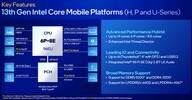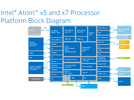Intel Core i5-1334U vs Intel Atom x7-Z8700
Intel Core i5-1334U
► remove from comparison
The Intel Core i5-1334U is a mid-range mobile CPU for thin and light laptops based on the Alder Lake architecture (Raptor Lake-U / RPL-U series). It was announced in early 2023 and offers 2 performance cores (P-cores, Golden Cove architecture) and 8 efficient cores (E-cores, Gracemont architecture). The P-cores support Hyper-Threading leading to 12 supported threads when combined with the E-cores. The clock rate ranges from 1.3 to 4.6 GHz on the performance cluster and 0.9 to 3.4 GHz on the efficient cluster. The performance of the E-cores should be similar to old Skylake cores (compare to the Core i7-6700HQ). All cores can use up to 12 MB L3 cache. The CPU supports only "Essentials" vPro management features. Compared to the P-series (28W) or H-series (45W), the 15W TDP may limit the sustained performance.
Performance
Thanks to the similar clock speed, the Core i5-1334U is very similar to the older Core i7-1250U (+100 MHz P-Cores base clock rate). The faster i7 like the i7-1365U models offer only higher clock rates (and a faster iGPU). Compared to the similar i5-1335U, the 1334U only supports slower LPDDR5-5200 (vs 6400 of the faster models) and is therefore slightly slower.
Architecture
The integrated memory controller supports various memory types up to LPDDR5-5200. The Thread Director (in hardware) can support the operating system to decide which thread to use on the performance or efficient cores for the best performance. For AI tasks, the CPU also integrates GNA 3.0 and DL Boost (via AVX2). Quick Sync in version 8 is the same as in the Rocket Lake CPUs and supports MPEG-2, AVC, VC-1 decode, JPEG, VP8 decode, VP9, HEVC, and AV1 decode in hardware. The CPU still only supports PCIe 4.0 x8 for a GPU and two PCIe 4.0 x4 for SSDs.
The integrated graphics card is based on the Xe-architecture and offers 80 of the 96 EUs (Execution Units) operating at up to 1.25 GHz.
Power consumption
This Core i5 CPU is rated at a TDP of 15W (base power, PL1) and a maximum turbo power of 55W (PL2). The RPL-U processors are built in a further improved Intel 7 process (10nm SuperFin) that allows higher clock rates.
Intel Atom x7-Z8700
► remove from comparison
The Intel Atom x7-Z8700 is a power efficient quad-core SoC for Windows and Android devices (tablets and convertibles), which has been presented in March 2015. It is clocked at 1.6 - 2.4 GHz and part of the Cherry Trail platform. Thanks to its new 14 nanometer low-power process (P1273) with tri-gate transistors, energy efficiency has been significantly improved compared to its predecessor Bay Trail-T (e.g. Atom Z3795). In addition to the CPU cores, the SoC offers a DirectX 11.2-capable GPU as well as a LPDDR3 Memory Controller (2x 64 bit, 25.6 GB/s).
Architecture
The processor cores are based on the Airmont architecture, which is basically a slightly modified shrink of the previous Silvermont core. While performance per clock has not been improved, the more efficient 14 nm process leads to a better utilization of the CPU Burst (alias Turbo Boost) and a therefore somewhat higher overall performance.
Performance
Compared to the Atom Z3795, the Atom x7-Z8700 offers about 5 percent more performance and is similar fast as an AMD A6-6210 APU or high-end ARM SoCs, e.g. the Snapdragon 810 or Exynos 7420.
Using Windows, the performance is adequate for everyday tasks such as Internet or Office, but not for very complex software or modern games.
Graphics
The HD Graphics (Cherry Trail) is based on the Intel Gen8 architecture, which supports DirectX 11.2 and is also found in the Broadwell series (e.g. HD Graphics 5300). With 16 EUs (Execution Units) and a clock speed of up to 600 MHz, the GPU is about twice as fast as the HD Graphics (Bay Trail) and will handle older and less demandig Windows games (e.g. Counter-Strike: GO) in low settings at decent frame rates. The GPU also supports 4K/H.265 video acceleration.
Compared to ARM SoCs, the HD Graphics offers a performance somewhere between the Qualcomm Adreno 330 / PowerVR G6430 and the Adreno 420 / PowerVR GX6450.
Power Consumption
The entire SoC is rated at an SDP of 2 watts, which indicates a TDP of less than 4 watts. Thus, the chip can be used in passively cooled tablets.
| Model | Intel Core i5-1334U | Intel Atom x7-Z8700 | ||||||||||||||||||||||||||||||||||||||||
| Series | Intel Raptor Lake-U | Intel Atom x7 | ||||||||||||||||||||||||||||||||||||||||
| Codename | Raptor Lake-U | Cherry Trail | ||||||||||||||||||||||||||||||||||||||||
| Series: Atom x7 Cherry Trail |
|
| ||||||||||||||||||||||||||||||||||||||||
| Clock | 900 - 4600 MHz | 1600 - 2400 MHz | ||||||||||||||||||||||||||||||||||||||||
| L1 Cache | 928 KB | |||||||||||||||||||||||||||||||||||||||||
| L2 Cache | 9.5 MB | 2 MB | ||||||||||||||||||||||||||||||||||||||||
| L3 Cache | 12 MB | |||||||||||||||||||||||||||||||||||||||||
| Cores / Threads | 10 / 12 | 4 / 4 | ||||||||||||||||||||||||||||||||||||||||
| TDP | 15 Watt | |||||||||||||||||||||||||||||||||||||||||
| Technology | 10 nm | 14 nm | ||||||||||||||||||||||||||||||||||||||||
| max. Temp. | 100 °C | 90 °C | ||||||||||||||||||||||||||||||||||||||||
| Socket | BGA1700 | |||||||||||||||||||||||||||||||||||||||||
| Features | Thread Director | Intel HD Graphics (Cherry Trail, 200 - 600 MHz), Wireless Display, AES-NI, max. 8 GB Dual-Channel LPDDR3-1600 (25,6 GB/s), 3x USB 3.0, 2x PCIe 2.0 | ||||||||||||||||||||||||||||||||||||||||
| iGPU | Intel Iris Xe Graphics G7 80EUs ( - 1250 MHz) | Intel HD Graphics (Cherry Trail) (200 - 600 MHz) | ||||||||||||||||||||||||||||||||||||||||
| Architecture | x86 | x86 | ||||||||||||||||||||||||||||||||||||||||
| Announced | ||||||||||||||||||||||||||||||||||||||||||
| Manufacturer | www.intel.com | ark.intel.com |


 Deutsch
Deutsch English
English Español
Español Français
Français Italiano
Italiano Nederlands
Nederlands Polski
Polski Português
Português Русский
Русский Türkçe
Türkçe Svenska
Svenska Chinese
Chinese Magyar
Magyar